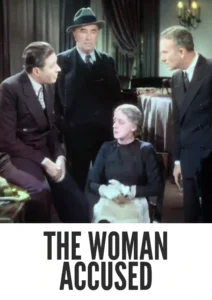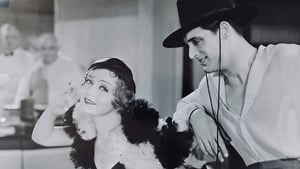Contact: info@alwanfilm.com
Video Sources 0 Views
- The Woman Accused


Synopsis
Table of Contents
ToggleReview: The Woman Accused 1933 Colorized – A Gripping Legal Drama Illuminated in Vivid Color

Introduction
“The Woman Accused” (1933) stands as a compelling testament to the enduring power of justice and redemption in the face of adversity. In this article, we’ll explore the significance of this early colored film, delving into its impact on audiences and its lasting legacy in the realm of legal drama.
Check The Full Colorized Movies List
Check Our Colorized Movies Trailer Channel
Understanding The Woman Accused 1933 Colorized: Director, Cast, and Genre
Directed by the esteemed Paul Sloane, “The Woman Accused” (1933) showcases his adeptness in crafting gripping narratives that resonate with audiences. The film features a talented cast, including Nancy Carroll and Cary Grant, whose performances breathe life into the complex characters that inhabit this legal drama. Blending elements of mystery, romance, and suspense, “The Woman Accused” (1933) takes viewers on a thrilling journey through the corridors of justice, where the truth is often elusive and the stakes couldn’t be higher.
Exploring the World of The Woman Accused 1933 Colorized: Plot and Characters
At its core, “The Woman Accused” (1933) follows the tumultuous journey of a young woman, played by Nancy Carroll, who finds herself entangled in a web of deceit and betrayal when she is wrongfully accused of a crime she didn’t commit. As she fights to clear her name and uncover the truth, she must navigate a labyrinth of legal obstacles and personal challenges, all while grappling with her own inner demons. Along the way, she encounters a cast of intriguing characters, each with their own motives and secrets, who complicate her quest for justice and redemption.
The Art of Film Colorization
Film colorization serves as a transformative tool that breathes new life into classic movies, allowing audiences to experience familiar stories in a fresh and vibrant way. By adding color to black and white films, colorization enhances the visual appeal of these timeless classics and introduces them to new generations of viewers. Through the use of advanced digital techniques, filmmakers can now recreate the look and feel of the original color palette, preserving the integrity of the original work while updating it for modern audiences.
Early Colored Films: A Brief History
The history of colored films dates back to the early days of cinema, with filmmakers experimenting with various techniques to add color to their creations. From hand-tinted frames to early Technicolor processes, the evolution of colored film has been marked by innovation and ingenuity, paving the way for the development of modern colorization techniques that continue to captivate audiences to this day.
The Woman Accused 1933 and Its Early Colored Version
The decision to release “The Woman Accused” (1933) in a colorized format was met with both excitement and apprehension. While some welcomed the opportunity to experience the film in vivid color, others expressed concerns about the potential impact on its visual aesthetic. Nevertheless, the early colored version of “The Woman Accused” (1933) offers viewers a fresh perspective on the timeless tale of justice and redemption, enhancing its emotional resonance and captivating audiences with its luminous beauty.
The Debate Over Film Colorization
The debate over film colorization continues to divide audiences and critics alike, with proponents praising its ability to breathe new life into classic movies and introduce them to a new generation of viewers, while detractors argue that it compromises the artistic integrity of the original work and diminishes its historical significance. As the debate rages on, filmmakers and audiences alike are left to ponder the merits and drawbacks of colorization in the ever-evolving landscape of cinema.
Examining The Woman Accused 1933 as an Early Colored Film
As with any colorized classic, the impact of colorization on “The Woman Accused” (1933) is a matter of personal interpretation. Some may argue that it enhances the film’s visual appeal and immerses viewers in its world, while others may feel that it detracts from the stark beauty of the original black and white version. Regardless of one’s stance on the issue, there’s no denying the enduring power of “The Woman Accused” (1933) as a timeless legal drama that continues to captivate audiences with its compelling narrative and unforgettable characters.
Influence and Legacy: The Woman Accused 1933 Colorized’s Impact on Cinema
“The Woman Accused” (1933) has left an indelible mark on the world of cinema, inspiring countless filmmakers and captivating audiences with its timeless tale of justice and redemption. From its gripping performances to its suspenseful plot twists, the film continues to resonate with viewers of all ages, reaffirming its status as a beloved classic of the legal drama genre.
Director’s Cinematic Legacy: Beyond The Woman Accused 1933 Colorized
Paul Sloane’s influence extends far beyond “The Woman Accused” (1933), with a diverse body of work that continues to captivate audiences around the globe. From “Hotel Haywire” to “Guilty Hands,” Sloane’s films are celebrated for their taut storytelling, dynamic characters, and thought-provoking themes, solidifying his legacy as one of the preeminent directors of Hollywood’s Golden Age. Through his groundbreaking work, Sloane has left an indelible imprint on the world of cinema, inspiring generations of filmmakers to follow in his footsteps.
Themes Explored in The Woman Accused 1933 Colorized
“The Woman Accused” (1933) explores a myriad of themes, from the pursuit of justice to the complexities of human nature. Through its richly drawn characters and nuanced storytelling, the film invites viewers to ponder the moral dilemmas that arise in the quest for truth and the consequences of our actions. As audiences immerse themselves in the world of “The Woman Accused” (1933), they are reminded of the enduring power of the human spirit to overcome adversity and seek redemption in the face of insurmountable odds.
Reception and Controversy Surrounding The Woman Accused 1933 Colorized
Upon its release, “The Woman Accused” (1933) received widespread critical acclaim, with many praising its gripping narrative, stellar performances, and breathtaking cinematography. However, the decision to release the film in a colorized format sparked debate among purists, reigniting the age-old discussion surrounding film preservation and artistic integrity. Despite the controversy, “The Woman Accused” (1933) remains a beloved classic that continues to resonate with audiences of all ages, reaffirming its status as a timeless masterpiece of the legal drama genre.
Where to Watch The Woman Accused 1933 Colorized Online
For those eager to experience the timeless magic of “The Woman Accused” (1933), the film is readily available on popular streaming platforms such as Netflix, Amazon Prime, and Hulu. Whether you choose to watch it in its original black and white format or the early colored version, “The Woman Accused” (1933) promises to transport you to a world of intrigue and suspense, where the pursuit of justice knows no bounds and the truth lies hidden beneath the surface.
FAQs About The Woman Accused 1933 Colorized
Q: Is “The Woman Accused” (1933) based on a true story? A: No, “The Woman Accused” (1933) is a fictional tale crafted by screenwriter Lewis R. Foster, who drew inspiration from real-life legal cases and courtroom dramas of the era.
Q: Who are the main actors in “The Woman Accused” (1933)? A: “The Woman Accused” (1933) features a talented cast led by Nancy Carroll and Cary Grant, whose electrifying performances bring the gripping story to life.
Q: What awards did “The Woman Accused” (1933) win? A: While “The Woman Accused” (1933) did not win any major awards, it received critical acclaim for its compelling narrative and stellar performances.
Q: Why was “The Woman Accused” (1933) released in a colorized format? A: The decision to release “The Woman Accused” (1933) in color was made to introduce the film to a new generation of viewers and enhance its visual appeal for modern audiences. While the choice to colorize the film sparked debate among purists, it ultimately allowed “The Woman Accused” (1933) to reach a wider audience and ensure its continued relevance in the annals of cinematic history.
Conclusion
“The Woman Accused” (1933) stands as a testament to the enduring power of justice and redemption in the face of adversity, captivating audiences with its gripping narrative and unforgettable characters. Whether viewed in its original black and white format or the early colored version, the film remains a timeless classic that continues to resonate with viewers of all ages, reaffirming its status as a masterpiece of the legal drama genre.










